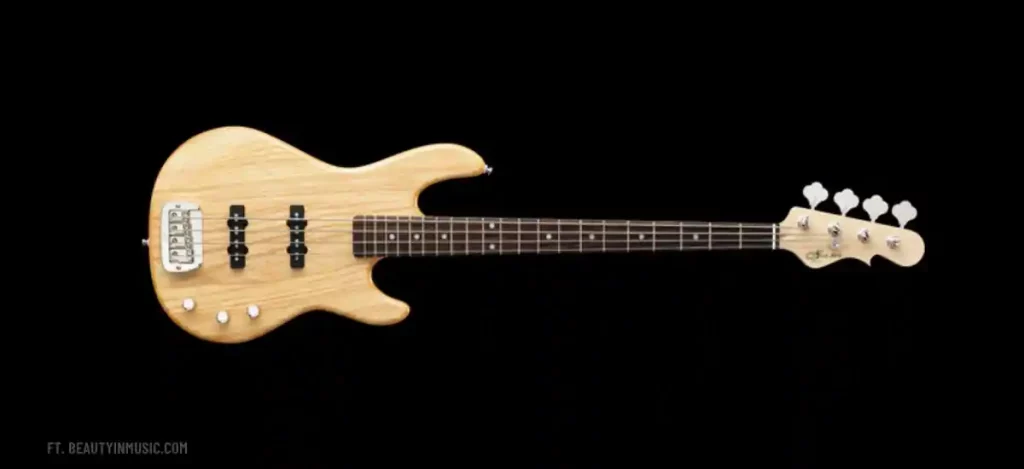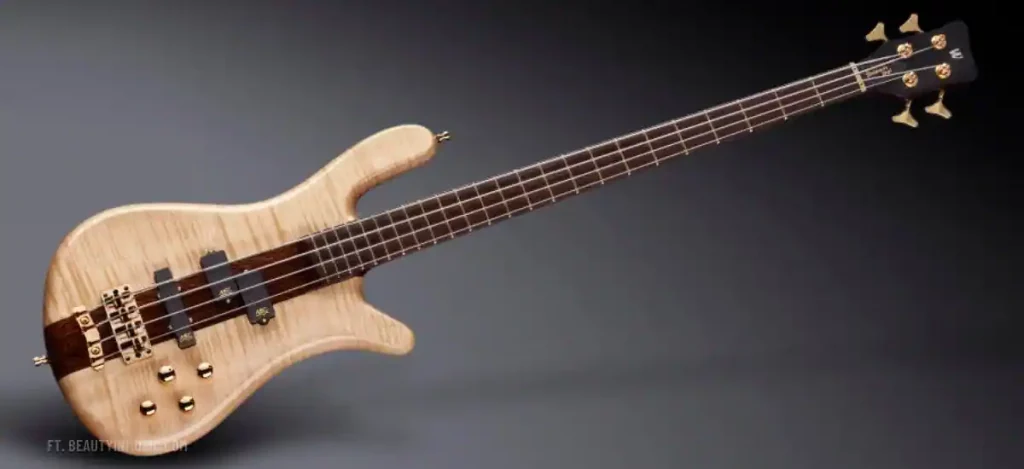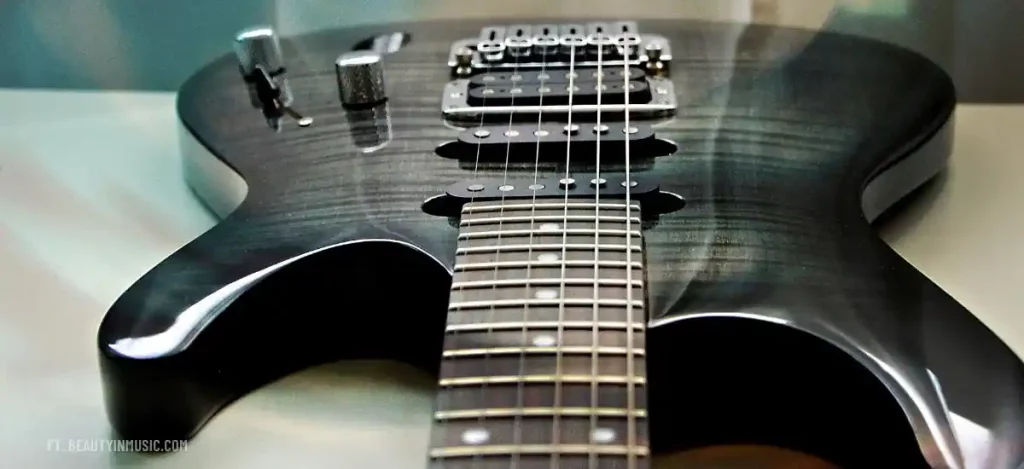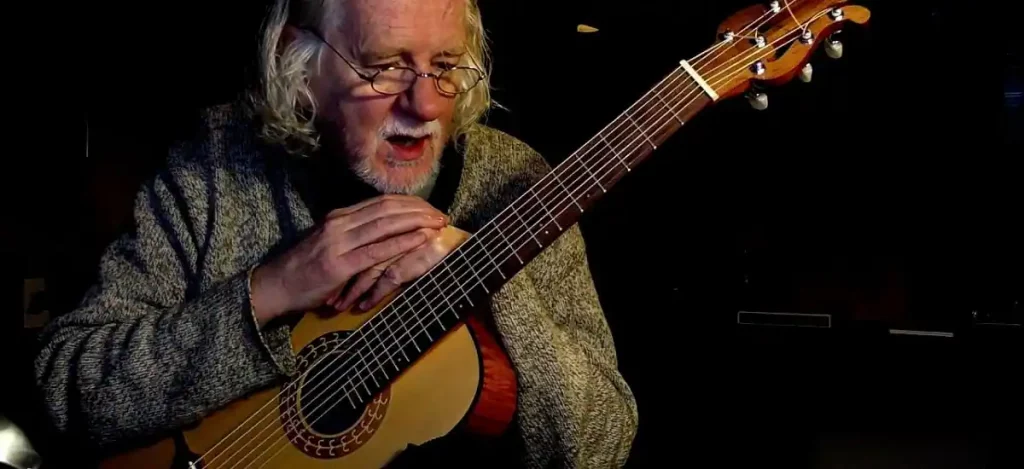THE STANDARD NUMBER OF STRINGS ON A GUITAR IS SIX.
The typical guitar has six strings, each with a different thickness. Starting from the thinnest, the strings are numbered 1 through 6. Strings 1 and 2 are referred to as “plain strings” and are made of bare steel.
Starting from the third string, metal is wound around the strings. When holding the guitar with the neck facing upwards, the sixth string is the topmost.
In this article, we’ll discuss the regular guitar, the number of strings it has, the variations available in string count, and which guitars have how many strings.
How Many Strings Does a Bass Guitar Have?
A standard bass guitar has four strings, tuned to the same notes as the lowest four strings on a guitar: E, A, D, and G. However, bass strings are thicker due to their lower pitch. Tuning a bass follows the same process as tuning a guitar.
1. G&L JB-2 Tribute

While a standard bass has four strings, more experienced musicians often use five- or six-string basses. In the late 1970s, virtuosos like Anthony Jackson started using these. A five-string bass typically includes a low B string, and a six-string bass adds a high C string.
2. Warwick RB Streamer Stage 1

Some musicians even play basses with seven or more strings to enhance their range and expressiveness. These are known as extended range basses (ERBs). While these are suitable for certain musicians, a four-string bass is generally sufficient for beginners.
3. Ibanez BTB1606

Many legendary bassists, both past and present, prefer four-string basses. This includes icons like Jaco Pastorius, Jeff Berlin, Marcus Miller, Stanley Clarke, Flea, Steve Harris, Jack Bruce, Chris Squire, and many others.
How Many Strings Do Multi-Neck Guitars Have?
Multi-neck guitars are fascinating and versatile instruments. The first multi-necked electric guitars, known as lap steels, gained popularity in Hawaii and eventually across America. Played on the lap, these guitars often feature more than 20 strings.

Modern multi-neck guitars can be both acoustic and electric, featuring multiple fretboard necks. The Gibson EDS-1275, made famous by Jimmy Page, is a well-known example. Depending on their design, these guitars can have various string counts.
The double neck guitar, featuring six-string and twelve-string necks, is the most common in contemporary music. Bill Bailey, for instance, owns and plays a 6-neck, 40-string guitar. Necks can be positioned on one side or both.
Multi-neck guitars allow musicians to switch between different guitar sounds (e.g., from a six-string electric to a bass) quickly and seamlessly without needing to change instruments mid-performance.
A Bit Of Guitar String Count History
The guitar’s origins trace back to Spain in the early 16th century, though some believe its earliest version appeared in Ancient Greece. According to legend, Hermes created the first guitar using a turtle shell. The term “guitar” likely derives from the Greek word “kithara.”
The oud and the lute are considered the guitar’s direct ancestors. These early instruments have a mysterious history but have been discovered in ancient Egyptian tombs and other significant archaeological sites.
During the Renaissance, lutes played a crucial role in European chamber music, evolving to accommodate up to 30 strings. The first guitars of this period had a more ergonomic design, making them easier to handle and play, leading to the guitar’s rise as the preferred string instrument by the mid-18th century.
Initially, guitars were made with five courses of gut strings and movable frets. By the late 18th century, luthiers began adding more string courses, bringing the instrument closer to the modern guitar.
Antonio de Torres Jurado is credited with creating the modern guitar. His design featured a flatter belly, greater curvature, and a more sophisticated tuning mechanism, setting a standard for future generations.
Andres Segovia is often recognized for popularizing the modern concert guitar. The “classical guitar” movement began in the early to mid-20th century, spreading across North and South America.
How Many Strings Does a Ukulele Have?
A ukulele is a small stringed instrument that can resemble a guitar, mandolin, or banjo when played with a fretted plectrum. Ukuleles come in various sizes, including soprano, concert, tenor, baritone, and even the rare bass ukulele. The strings are the most critical component of a ukulele.

Typically, a ukulele has four strings, unlike a guitar, which has six. The standard tuning for a ukulele is G-C-E-A, producing a C6 chord when played open.
When selecting ukulele strings, it’s essential to consider the instrument’s total length and scale length—the distance from the nut to the bridge, determining the vibrating string length.
Some ukuleles have six or even eight strings, allowing for diverse tones and playing techniques.
Related Post:- How Can I Choose A Harmonica To Avoid Pass Out
How Many Strings Does An Electric Guitar Have?
The electric guitar’s cultural and emotional impact is immense, from Keith Richards’ iconic riffs on his Telecaster to Adam Granduciel’s intricate solos on his Jazzmaster.
While acoustic and electric guitars share a similar basic construction, key differences give the electric guitar its unique sound. Electric guitars feature volume and tone knobs, unique bridge saddles, and other components that contribute to their distinctive tone.
A standard electric guitar has six strings. When tuned to Open E, the notes for each string are as follows:

- 1st string (thinnest) – high E
- 2nd string – B
- 3rd string – G
- 4th string – D
- 5th string – A
- 6th string (thickest) – low E
To remember the string notes, think of the mnemonic: “Easter Bunnies Get Dizzy At Easter.”
How Many Strings Does An Acoustic Guitar Have?
Experienced acoustic players might consider upgrading to a 12-string acoustic guitar for a richer sound. It is tuned similarly to a 12-string electric guitar and requires pressing down on two strings simultaneously with the same finger.
Standard tuning for an acoustic guitar is E, A, D, G, B, and E. Acoustic guitars can have either nylon or steel strings.
A six-string acoustic guitar typically has between 19 and 28 frets, offering a range of about four octaves. Most students start with one of these models when learning to play the guitar.
How Many Strings Does A Classical Guitar Have?

A classical guitar with more than six strings, known as an extended-range guitar, features additional strings that can be “stopped” or fretted. These guitars are distinct from harp guitars, which have extra strings that do not pass over a fingerboard.
Guitar historian Matanya Ophee discovered that seven-string classical guitars existed in Europe in the late 18th century. Andrei Sychra, an early adopter, composed over a thousand pieces for the seven-string guitar, with many compositions reissued between the 1840s and 1880s.The Russian seven-string guitar, originally a gut-string instrument, was tuned to an open ‘G’ chord:
FAQs
1. Did guitars always have six strings?
No, guitars did not always have six strings. Early guitars had different string counts. Today’s market offers guitars with fewer or more than six strings.
2. What is a 12-string guitar called?
The bouzouki was one of the first mass-produced electric 12-string instruments, introduced by Danelectro in 1961 and based on a design by session musician Vinnie Bell. It combined elements of an electric guitar and a bouzouki.
3. What is a 7-string guitar used for?
Seven-string guitars are used in classical, jazz, progressive rock, and heavy metal music. They are valuable in a band context because the lowest note (B1) matches the B0 often used on five-string or more bass instruments.

